Bulletin – September 2017 Australian Economy The Rising Share of Part-time Employment
- Download 619KB
Abstract
One of the most significant changes to the Australian labour market in recent decades has been the rise in the share of part-time employment to account for nearly one-third of total employment. This article details the various supply and demand factors that have underpinned the increase in part-time employment, as well as some of the characteristics of part-time workers. Because there are some part-time workers who want to work additional hours, it is useful to consider underemployment as well as unemployment in measuring labour market spare capacity.
Introduction
The structure of the Australian labour market has gradually changed over recent decades, reflecting developments in both labour supply and demand. One of the most significant changes has been the large increase in part-time employment, classified by the Australian Bureau of Statistics (ABS) as working less than 35 hours across all jobs in a usual working week. The part-time employment share has risen steadily to now account for nearly one-third of total employment (Graph 1). On the supply side, this has allowed employees to combine paid work with other activities such as education, caring for family members and leisure. On the demand side, firms are using more flexibility in the workforce to respond to fluctuations in demand for their output and to manage labour costs more effectively.
Many advanced economies have also experienced a trend increase in the share of part-time employment over recent decades. However, Australia has one of the highest shares of part-time employment across OECD countries, even when using a more restrictive definition of part-time employment for international comparability (Graph 2).
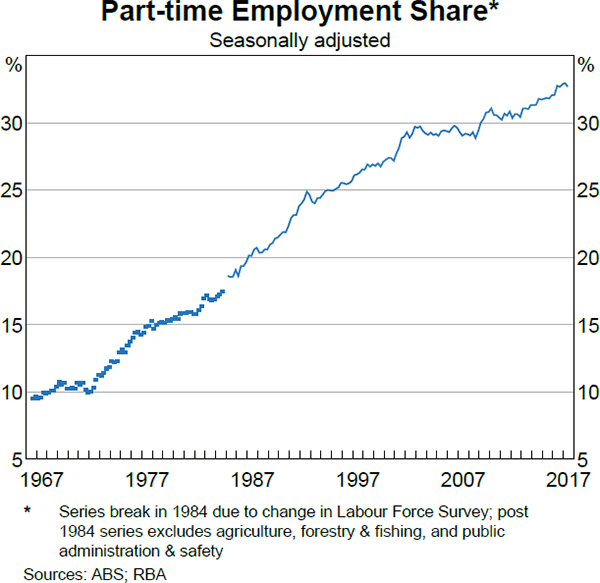
While part-time employment encompasses a range of actual hours worked, part-time employees work an average of 17 hours per week. More than half of Australia's part-time workers are casually employed, compared with 10 per cent of full-time workers. Casual employment is defined here as employment with no paid holiday or sick leave. Perhaps somewhat surprisingly given the continued upward trend in the part-time employment share, the share of casual employees in the workforce has been relatively stable since the 1990s at around 20 per cent. The share of independent contractors working part time is around 40 per cent. Independent contractors own their own business and are contracted to perform services by a client; they represent close to 10 per cent of employment.
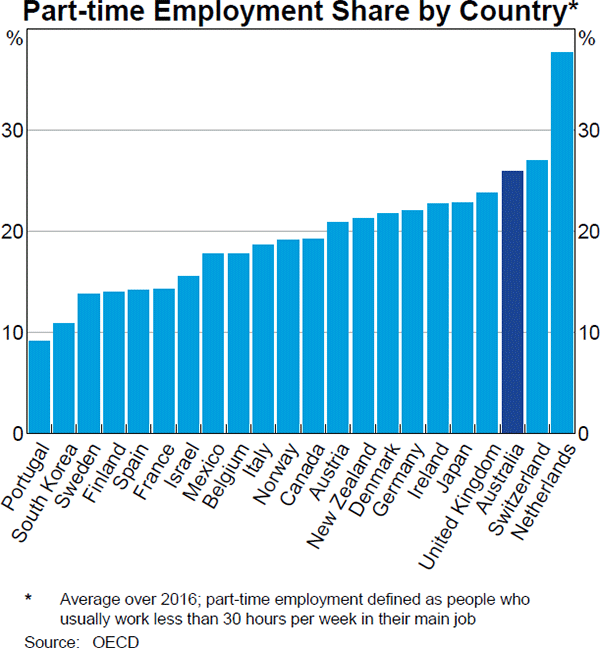
Drivers of the Rising Part-time Employment Share
Labour supply factors
Many people choose to work part time. Data from the Household, Income and Labour Dynamics in Australia (HILDA) Survey suggest that the three most common reasons for working part time are to accommodate study, a preference for part-time hours and caring for children.[1] Collectively, these account for around two-thirds of part-time employees and this has been broadly the case since the survey began in 2001 (Graph 3).
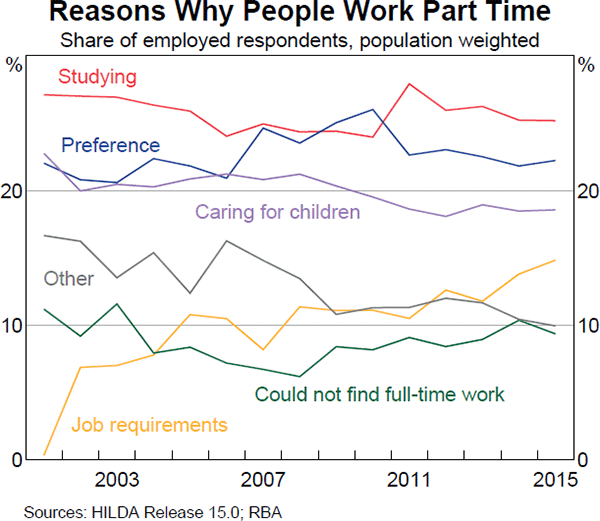
These three reasons for working part time are consistent with the share of part-time employment being highest for two groups: those aged under 25 years and females (Graph 4). For younger workers, the part-time share has increased from 15 per cent of employment in 1980 to over 50 per cent, with these workers tending to cite study as their main reason for working part time (Graph 5). Just over half of 15–24 year olds are now enrolled in full-time education, which is an increase from 30 per cent in the mid 1980s. While government reforms in the late 1980s increased access to higher education, notable increases in participation in post-secondary education (in particular for younger males) occurred after the decline in full-time employment opportunities in the 1980s and 1990s recessions (Department of Education and Training 2015). The participation rate of younger Australians in the labour force is one of the highest in the OECD; the relatively high share of young people in Australia combining study and work can help explain the high share of part-time employment relative to the OECD average.
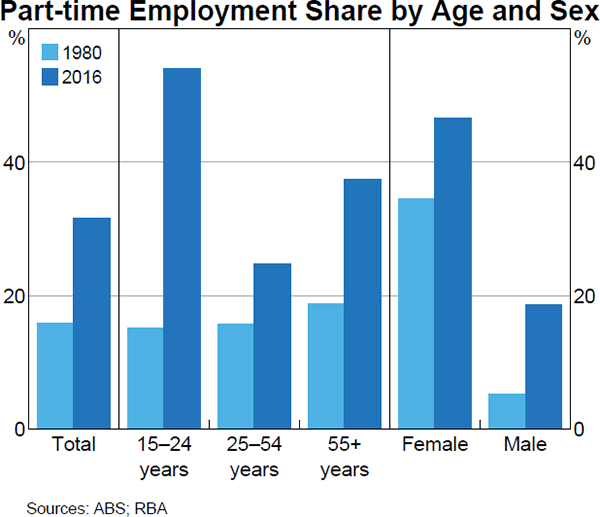
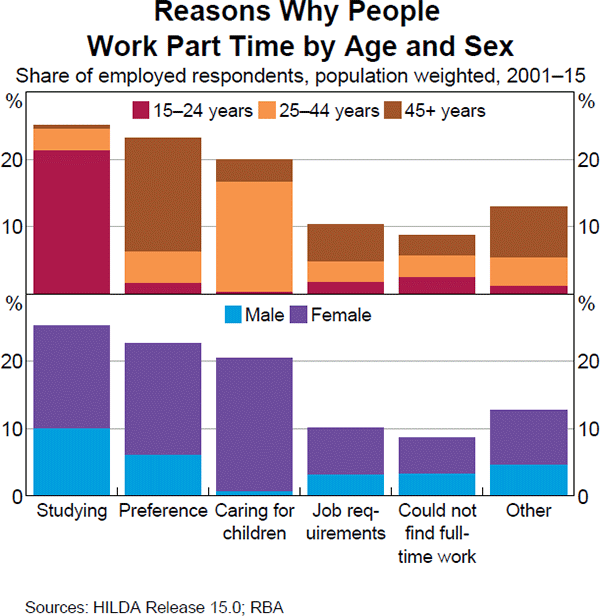
The participation rate of women in the labour force has increased from 40 per cent in 1970 to 60 per cent in 2017. Close to half of employed females currently work part time. Prime-aged (25–44 year old) females indicate caring for children as the dominant reason for working part time, although this has become a little less pervasive over the past decade. In contrast, the share of males working part time to care for children is relatively small.
The relationship between child care responsibilities and part-time work is complex; some parents may choose to work part-time hours to spend more time caring for children, whereas other parents may prefer additional or full-time hours but are unable to find or afford adequate child care arrangements. Parental leave options are also a significant consideration. According to the HILDA Survey, around 75 per cent of couples with children under 15 years had some difficulty with the cost of child care in 2015, compared with about 60 per cent in 2001. Around 60 per cent of couples with children under 15 years also reported having difficulty finding good quality child care. In Australia, the most common employment arrangement for couples with dependent children is having one partner work full time and the other part time. In contrast, the most prevalent work arrangement across OECD countries is for both partners to work full time.
Relative to other age groups, older workers (particularly those aged 55 years and over) have the strongest preference for working part-time hours. It may be that older workers take on a part-time job (and, increasingly, casual arrangements) as a transition between the role they had for most of their working life and retirement. Older workers also cite caring for relatives and illnesses or disabilities as reasons for working part time. In addition, an older worker's decision to work part-time hours can be influenced by access to, and the level of, pensions and superannuation.
Labour demand factors
A number of long-run labour demand factors have contributed to the changing employment structure of the economy. Firstly, the economy has become more services-oriented as households have become older and wealthier. This has resulted in a large increase in employment in service areas of the economy, such as health, education, tourism and hospitality. The nature of these jobs can involve irregular hours and this has meant that part-time and casual work are more common in these industries. For example, around 60 per cent of employment in the accommodation and food services industry is in part-time work (Graph 6). As these industries have become more important in the economy, this has contributed to the overall rising share of part-time work. At the same time, there has been a secular decline in traditionally full-time jobs in industries that have been dominated by routine manual jobs, such as manufacturing (Heath 2016).
There is also evidence to suggest that firms are increasingly using part-time employment to respond to cyclical fluctuations in demand for their output. Bishop, Gustafsson and Plumb (2016) found that, since the 1990s, businesses have increasingly responded to changes in labour demand by changing the hours worked by their employees rather than the number of employees. This may be due to a range of factors: the severity of the downturns has been less pronounced since the 1990s; the cost of hiring and training new employees has increased; and labour market reforms in the late 1980s and early 1990s have made it easier for firms to bargain directly with employees on wages and working arrangements. The authors suggest that the process of adjusting the hours of employees may have tempered the rise in unemployment during recent downturns.
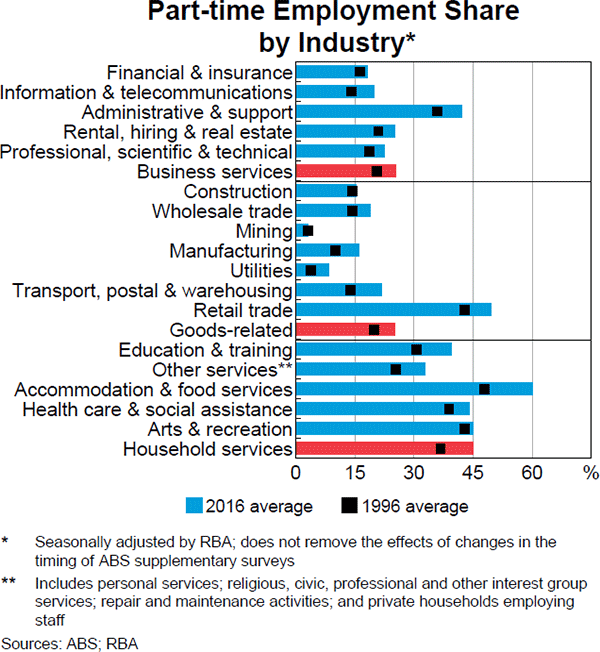
Another driver of demand for part-time employment is that firms have increasingly relied on part-time and casual employment to improve the flexibility of their business models. This has often been enabled by market reforms in recent decades. For example, the liberalisation of retail shopping hours increased the number of workers employed on non-standard hours and working on a part-time basis. Improved technological systems have also allowed firms to manage staff hours more efficiently and facilitated the automation of certain processes. Consistent with these developments, the share of part-time employment has risen in all industries, including industries traditionally dominated by full-time employment. In addition, information from the Bank's liaison program suggests that businesses make use of employees of labour hire firms or employ staff on fixed-term contracts as ways to adjust to changes in labour demand, or to differentiate the wages between existing and new staff.
From a firm's perspective, less idle labour during off-peak periods may enable a business to run more efficiently. However, there are also costs to firms from employing part-time workers. A firm will encounter the same hiring and overhead costs as employing a full-time worker, though part-time workers on average have shorter job tenures than full-time workers (driven by casual part-time employees). There may also be differences in the relative productivity of part-time and full-time workers (Abhayaratna et al 2008).
While data from the HILDA Survey suggest that many people choose to work part time, the survey also found that around one-quarter of part-time workers were employed in a part-time capacity in 2015 because they could not find a full-time job or because part-time hours were a requirement of their job (Graph 3). The latter reason has increased from around 10 per cent of part-time workers in 2011 to 15 per cent in 2015; the change has been most pronounced for males and for those aged 45 years and over. Consistent with this, ABS data suggest that around one-quarter of part-time workers (about 8 per cent of the labour force) want to, and are available to, work more hours than they currently do. On average, these underemployed part-time workers would like to work an additional 14 hours per week; around 15 per cent of all part-time workers desire enough additional hours to become full-time workers. In 2014, around 40 per cent of all underemployed part-time workers were actively seeking additional hours, for example by responding to job advertisements and asking their employer for additional hours.[2]
Implications for Spare Capacity
Underlying the changes in aggregate labour market outcomes, there are much larger flows of individuals moving into and out of part-time employment, full-time employment, unemployment and the labour force. The flows between all of these labour market ‘states’ depend on longer-run structural changes as well as cyclical developments.
Data from the HILDA Survey suggest that, on average, a little less than 20 per cent of part-time workers switch to full-time employment each year. In contrast, less than 10 per cent of full-time workers switch to part-time work on average each year. As previously mentioned, many young people combine part-time work and study, while unemployed workers more commonly transition to part-time (particularly casual) jobs rather than full-time work. This provides some evidence that part-time work can be used as a stepping stone into full-time employment.
Gross flows data from the ABS Labour Force Survey show that there were fewer people than usual transitioning from part-time work to full-time work over 2016. This tends to happen during periods of slower labour demand; indeed, during the slowdowns in 2001 and 2009, there was a small net outflow from full-time employment to part-time employment as firms adjusted hours due to weaker demand. As discussed earlier, this tendency to adjust hours rather than heads may have slowed the rise in unemployment, particularly during the 2009 slowdown.
The increasing flexibility of hours worked has a number of implications. The rise in part-time employment over the past few decades has contributed to an increase in labour market participation, but also means there are more part-time workers who are willing and able to work additional hours. This warrants monitoring a broader range of measures of labour market spare capacity alongside the more conventional unemployment rate or unemployment gap.[3]
There are a number of ways to include part-time workers who want to work more hours in an underutilisation measure. One measure that has conceptual appeal is an hours-based underutilisation rate. This measures the additional hours sought by workers (including those currently unemployed) relative to the total number of hours that workers would like to work. The steady rise in part-time employment over recent decades has been accompanied by a rise in this underutilisation rate (Graph 7). It shows the same general pattern as the unemployment rate, although the gap has tended to widen since 2011.
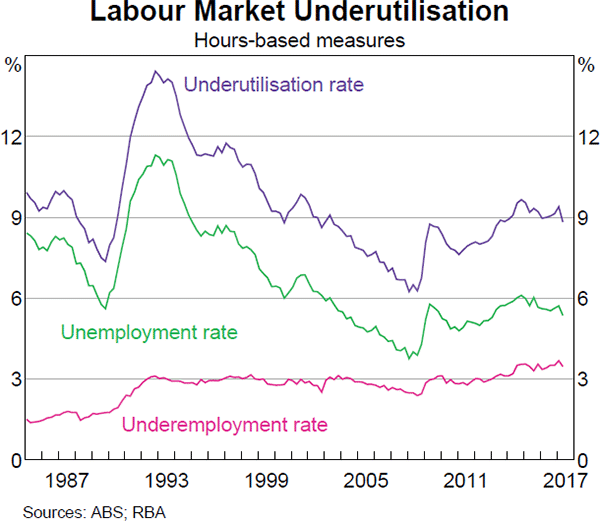
Implications for Wages
The characteristics of part-time workers can influence both the level of employees' wages and their bargaining power. As is the case in many other countries, Australian part-time workers earn an average hourly wage that is lower than full-time workers. However, unlike some other countries, there is no evidence that part-time workers in Australia face a wage penalty once other factors (such as industry, job tenure and education) are controlled for (Booth and Wood 2008; Day and Rodgers 2013).
Part-time workers have a tendency to work in industries and occupations with below-average levels of pay. For example, part-time workers are more commonly employed in routine cognitive occupations (such as sales and clerical roles) than full-time workers (Graph 8). In contrast, over 40 per cent of full-time workers are employed in non-routine cognitive occupations, which tend to earn the most per hour on average. There has also been an increase in the share of part-time workers employed in non-routine manual occupations over the past decade, which include occupations related to assisting or caring for others.[4]
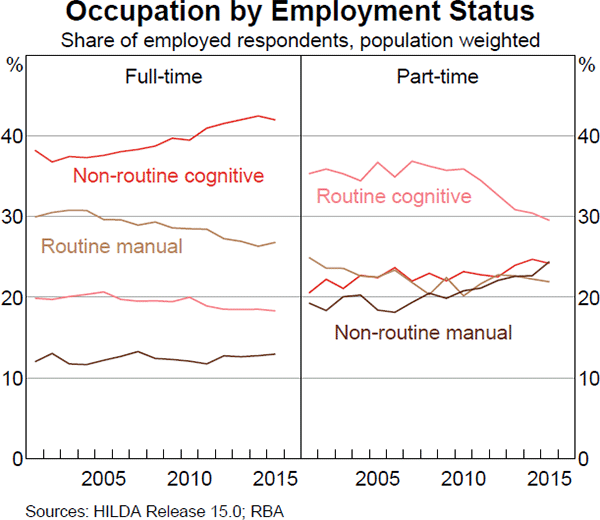
A smaller share of part-time workers aged over 24 years have post-school qualifications (around 60 per cent) compared with full-time workers (around 70 per cent). On average, part-time workers have spent a shorter amount of time with their current employer than full-time workers, though, as previously mentioned, this is entirely attributable to casual workers (Graph 9). On average, permanent part-time employees have had the same job for around eight years, one year longer than the average full-time employee. Compared with full-time workers, part-time workers less commonly belong to unions; casual workers have a particularly low union membership rate. In addition, the average part-time worker is less likely to have been promoted or completed work-related training in the past year than the average full-time worker.
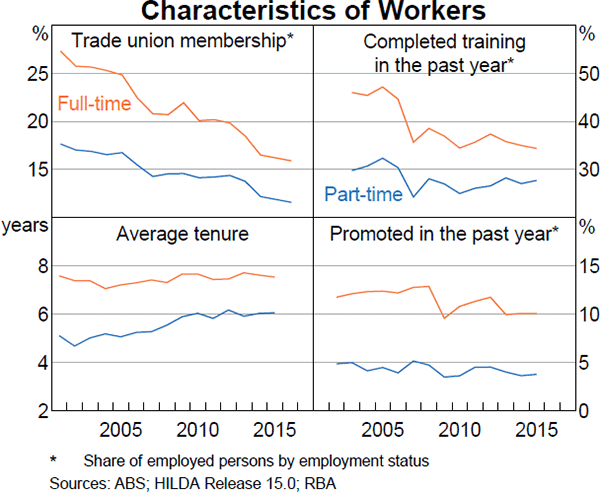
Data from the HILDA Survey suggest that full-time workers have more commonly reported high satisfaction with job security than part-time workers, though in recent years there has been little difference (Graph 10).[5] An alternative measure of job security – workers' perceptions that they will retain their job in the next year – has typically been higher for part-time workers than full-time workers. This is because permanent part-time workers have much more certainty that they will retain their job in the next year compared to both casual part-time workers and full-time workers, and is consistent with permanent part-time workers reporting the highest overall job satisfaction.[6]
It may also be the case that part-time workers have less bargaining power in wage negotiations given that they have lower union membership rates and some part-time workers have lower perceptions of job security. Haldane (2017) argues that shifts in working patterns in the UK, such as lower union membership and the increasing incidence of self-employment, flexible work, part-time work and zero-hours contracts have contributed in some way to weak wage growth in the UK.[7] For Australia, apart from the rise in the part-time employment share, it is difficult to find much evidence that there has been an increase in the share of workers employed on temporary contracts or working for a labour hire firm over the past decade. Data from the HILDA Survey suggest that less than 10 per cent of employees were on a fixed-term contract in 2015 and this share has been little changed over the last 15 years, while ABS data suggest that around 1 per cent of workers were paid directly by a labour hire firm in August 2016, down from 2 per cent in 2001.
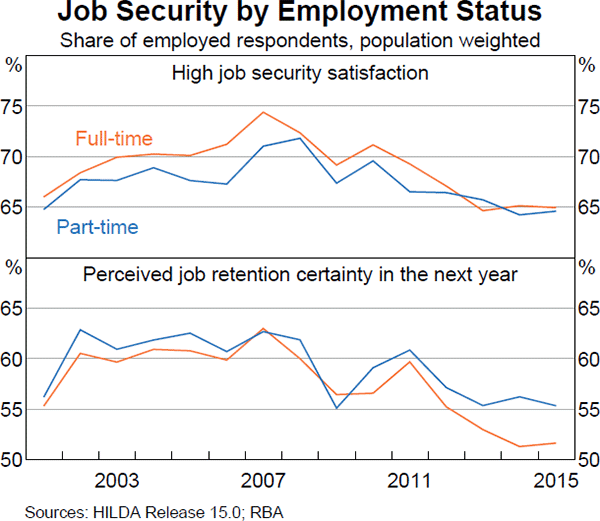
The Bank has previously noted that subdued growth in wages over recent years can largely be explained by the unemployment gap, the decline in the terms of trade and lower inflation outcomes (Bishop and Cassidy 2017). However, these determinants cannot fully explain the decline in wage growth over this period. One plausible reason is that there is more spare capacity in the labour market than suggested by the unemployment gap. In recent years, the broadest measure of hours-based underemployment has increased while the unemployment rate has declined a little. The relationship between labour underemployment and wage growth is somewhat complex. The presence of underemployed workers could dampen wage growth given they offer additional labour supply to the pool of unemployed workers.[8] From a modelling perspective, the addition of a measure of part-time underutilisation has some explanatory power in a wages Phillips curve, and, at the margin, may have contributed to the decline in wage growth in recent years.
Conclusion
There has been a trend increase in the share of part-time employment for several decades as a result of supply and demand factors. While the majority of part-time workers appear to be working part-time hours voluntarily, there is a pool of part-time workers who want to, and can, work additional hours. These workers represent additional spare capacity in the labour market that should be considered when assessing wage and price pressures in the economy.
Footnotes
Natasha Cassidy is from Economic Analysis Department and Stephanie Parsons completed this work in Economic Research Department. [*]
See Abhayaratna et al (2008) for a comprehensive review of the extent and nature of part-time work in Australia. [1]
These data are no longer available from the ABS. [2]
The unemployment gap is the difference between the unemployment rate and the unemployment rate that is associated with a stable rate of inflation (known as the non-accelerating inflationary rate of unemployment or NAIRU). See Cusbert (2017) for more detail. [3]
This grouping of occupations was first used by Autor, Levy and Murnane (2003). Routine manual occupations include labourers and machinery operators in manufacturing and construction; routine cognitive occupations include salespeople and administrators; non-routine manual occupations include service occupations related to assisting others; and non-routine cognitive occupations include management and professional occupations. [4]
In aggregate, perceptions of job security have tended to track labour market conditions fairly closely (Bishop and Cassidy 2017). [5]
Borland (2017) uses ABS data to suggest part-time workers have a higher expectation of leaving their job over the year ahead than full-time workers. A reconciliation between the ABS data and the HILDA data shown in this article is that the latter only measures a worker's subjective probability of losing their job rather than the subjective probability of voluntarily leaving their job. [6]
Under zero-hours contracts, employers are not obliged to provide workers with a minimum number of hours and workers are not obliged to accept a minimum number of hours. [7]
Alternatively, it may be the case that lower wage growth could lead to higher underemployment in that workers may desire more hours than otherwise to boost income growth. [8]
References
Abhayaratna J, L Andrews, H Nuch and T Podbury (2008), ‘Part Time Employment: The Australian Experience’, Productivity Commission Staff Working Paper. Available at <http://www.pc.gov.au/research/supporting/part-time-employment/part-time-employment.pdf>.
Autor D, F Levy and R Murnane (2003), ‘The Skill Content of Recent Technological Change: An Empirical Investigation’, Quarterly Journal of Economics, 118(4), pp 1279–1333.
Bishop J and N Cassidy (2017), ‘Insights into Low Wage Growth in Australia’, RBA Bulletin, March, pp 13–20.
Bishop J, L Gustafsson and M Plumb (2016), ‘Jobs or Hours? Cyclical Labour Market Adjustment in Australia’, RBA Research Discussion Paper No 2016-06.
Booth A and M Wood (2008), ‘Back-to-Front Down Under? Part-Time/Full-Time Wage Differentials in Australia’, Industrial Relations: A Journal of Economy and Society, 47(1), pp 114–135.
Borland J (2017), ‘Job Insecurity in Australia – No Rising Story’, Labour Market Snapshot No 39, July. Available at <https://drive.google.com/file/d/0B_H1wGTm98W3UmF3S2lVSm8zUWc/view>.
Cusbert T (2017), ‘Estimating the NAIRU and the Unemployment Gap’, RBA Bulletin, June, pp 13–22.
Day I and J Rodgers (2013), ‘The Premium for Part-Time Work in Australia’, Department of Economics, University of Wollongong Working Paper 13-04.
Department of Education and Training (2015), ‘Higher Education Funding in Australia: A review of reviews from Dawkins to today’. Available at <https://docs.education.gov.au/node/38481>.
Haldane A (2017), ‘Work, Wages and Monetary Policy’, Speech at the National Science and Media Museum, Bradford, 20 June. Available at <http://www.bankofengland.co.uk/publications/Documents/speeches/2017/speech984.pdf>.
Heath A (2016), ‘The Changing Nature of the Australian Workforce’, Address to CEDA – Future Skills: The Education and Training Pipeline, Brisbane, 21 September.